Several small and harmless wild animals like the Malabar Giant Squirrel, barking deer, sambar deer, wild rabbits etc., thrive in and around the Tall Trees Resort, and are easily sighted. The streams abound in mountain game fish and rare varieties of small fishes. Numerous butterflies, moths and other colourful insects can be observed at close quarters. There are plenty of birds that sing from the tree tops and bushes all around in the morning and evening. Thrushes, warblers, bulbuls, shrikes, woodpeckers, mynahs, flycatchers, pigeons, parakeets, etc., abound in the green shade. There are also rare frogs, toads and other amphibians in the streams.
Dry-season brood. Male upper side: deep sulphur-yellow. Fore wing: base and basal half of costa thickly irrorated with black scales; apical half of the wing black, with an enclosed, large, irregularly triangular, orange-coloured patch, the apex of which is more or less broadly rounded and blunt; the orange colour extends into the apex of the cell bat, is interrupted there by a black disco-cellular spot that spreads diffusely inwards and joins the black oblique bar which forms the base of the orange patch; veins that traverse this latter, black.
Tawny Coster is a small leathery winged butterfly which is common in grassland and scrub habitats. It belongs to the Nymphalidae or brush-footed butterfly family. It has a weak fluttery flight. It is avoided by most insect predators. This species and the Yellow CosterAcraeaIssoria are the only two Indian representatives of the predominantly African tribe Acraeini.
Also known as Caper White, is a migrant butterfly found throughout India except for Assam and other eastern states. The upper side of the butterfly is pure white with black apex in the forewings and black outer margins in both wings. There is a hockey stick like spot in the middle of the forewings. On the under-side, there are spots in the apex, yellowish in forewings and yellow with black veins in hind wings. Wingspan is 50-60 mm.
A large butterfly, with a wing span 5-9 cm, identified by the black and white corners of its mainly deep orange wings with black and white spots. It has five white spots in the black tips of the fore-wings. There are four small sub-marginal eyespots on the white tips of the hind-wings. It has a lifespan of two to four weeks. Recent micro-tomography investigations have revealed that the species undergoes complete metamorphosis.
A very striking, large, black and crimson swallowtail with a wingspan of 85-115 mm. The body is bright crimson and velvety black, a warning coloration advertising predators of its distastefulness, a phenomenon referred to as aposematism, not restricted to butterflies but also many other organisms such as fish and snakes. These colour combinations have evolved over time to instruct predators of their unpalatability.
A large swallowtail butterfly with a wingspan of 80-95 mm. Sexes alike, but the males are smaller with narrower wings and less white on the forewing. The upper sides and undersides of both sexes are black. There is a well defined white patch in the centre of the hind wing and a series of crimson spots below. The crimson spots are much brighter on the lower side and are of a different hue.
Common Crow is a common butterfly found in South Asia. It belongs to the Crows and Tigers subfamily of the Nymphalidae (Brushfooted butterflies). The Common Crow is the most common representative of its genus Euploea. The Crows are inedible and thus mimicked by other Indian butterflies. In addition, the Indian species of the Euploea genus shows Müllerian mimicry.
Upper side rich velvety dark brownish black. Fore wing: a broad oval oblique white spot from below vein 3 to vein 7, and a preapical smaller similar white spot; both spots crossed by black veins and surrounded by iridescent blue. Hind wing with a much larger similar rounded white spot, surrounded with iridescent blue, but the veins crossing it is yellowish, and not so prominent as on the fore wing; two or three minute specks of white at the tornus. Cilia of both fore and hind wings have white alternated with black.
The Plain Tiger is a medium sized butterfly with a wingspan of about 7-8 cm. The body is black with many white spots. The wings are tawny, the upper side being brighter and richer than the underside. The apical half of the fore wing is black with a white band. The hind wing has 3 black spots around the centre. The hind wing has a thin border of black enclosing a series of semicircular white spots.
Closely resembles Tirumala limniace, Cramer, but is always sufficiently distinct to be easily recognized, even on the wing. From T. limniace it differs on the upper-side in the ground-colour being darker and the semi-hyaline markings narrower, more distinct, and of a bluer tint. In the fore wing, in inter space one the two streaks are narrower, never coalescent, the upper one forming an oval detached spot; the short streaks above vein 5 outwardly never truncate, always acute.
Common Grass Yellow is a small pierid butterfly species found in Asia. They are found flying close to the ground and are found in open grass and scrub habitats. It is simply known as "the grass yellow" in parts of its range; the general term otherwise refers to the entire genus Eurema.
The Common Lime or the Lemon Butterfly is a common and widespread Swallowtail butterfly. It gets its name from its host plants which are usually citrus species such as the lime. It is also sometimes called the Chequered Swallowtail. Unlike most swallowtail butterflies it does not have a prominent tail.
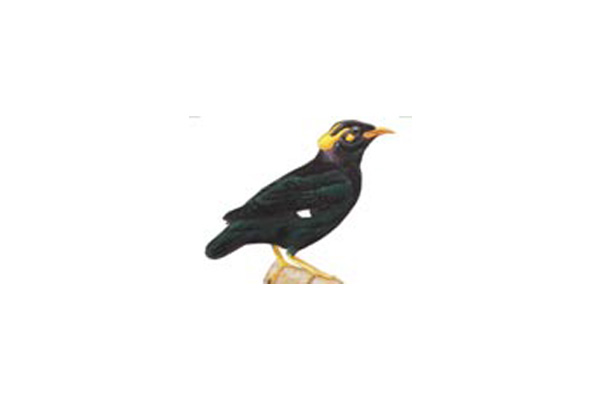
25-29 cm: Resident of the Himalayan foothills, hills of India, Bangladesh and Sri Lanka. The adult mynah has yellow wattles, large orange to yellow bill, and white wing patches. Juvenile has duller yellowish-orange bill, paler yellow wattles, and less glossy plumage. Habitat: Moist forests and plantations
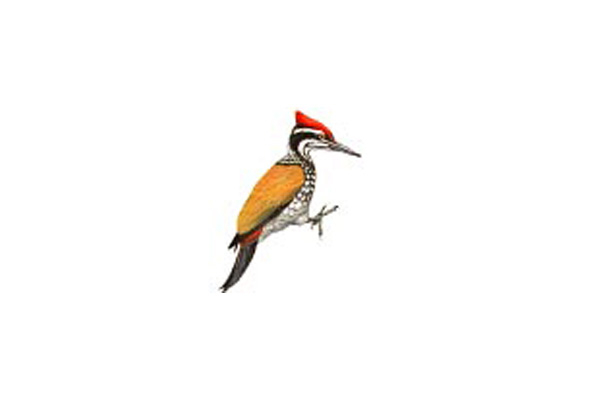
33 cm: Resident of the Himalayas, hills of India, Bangladesh and Sri Lanka. It has white or black-and-white spotted hind-neck and upper mantle, large size, and long bill. Moustachial stripe is clearly divided. Female has prominent white spotting on crown and crest. Sri Lankan race stricklandi has crimson upper-parts. Habitat: Forests and groves
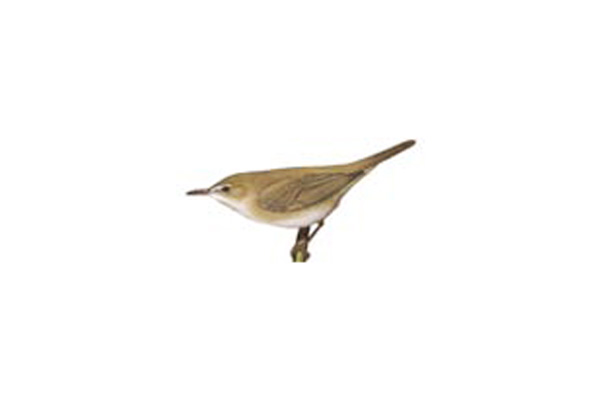
14 cm: Widespread winter visitor and passage migrant. It has long bill, olive-brown to olive-grey upper-parts and uniform wings. Comparatively indistinct supercilium is barely apparent behind the eye. Habitat: Among bushes and trees at the edges of forest cultivation and in wooded areas
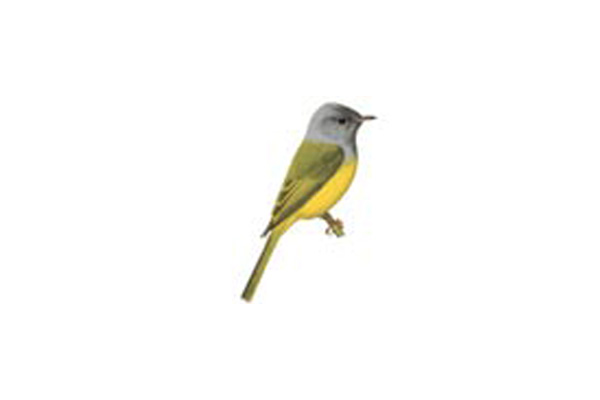
13 cm: Breeds in Himalayas, hills of India, Bangladesh and Sri Lanka; winters in Himalayan foothills, and plains in Pakistan and east and northeast India. Grey head and breast, yellow rest of under-parts, and greenish upper-parts. Habitat: Forests and wooded areas
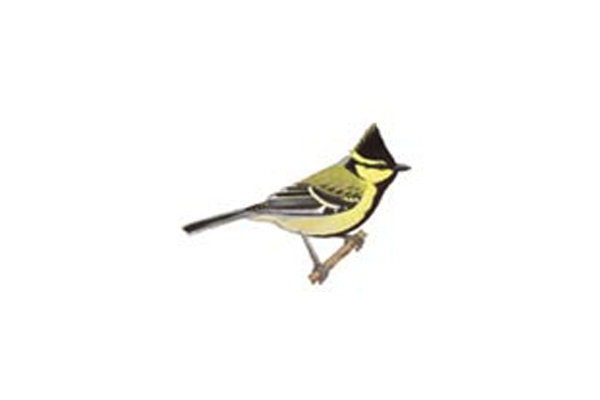
13 cm: Resident of the Himalayas and peninsular hills, where ranges overlap in the Himalayas. It is best told from Yellow-cheeked by black forehead and lores, uniform greenish upper-parts with black streaking confined to scapulars, olive rump, and yellowish wing-bars. Two races in the peninsula have white wing-bars (adult) and show sexual variation, most marked in travancoreensis where female has greyish olive crest and mantle. Habitat: Open forests, forest edges and plantations
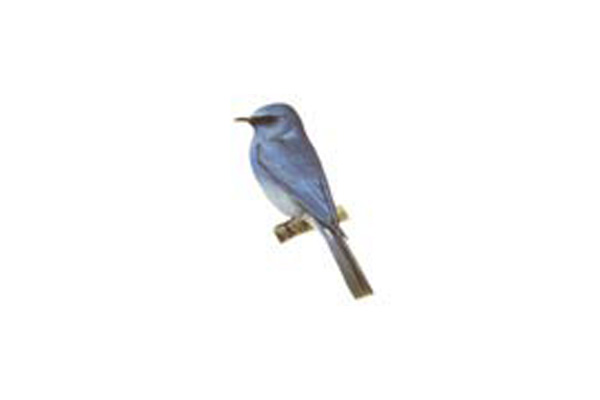
15 cm: Resident of the Western Ghats. White on tail-base and diffuse whitish frings to blue-grey under-tail coverts. Male is indigo-blue, with blue-grey belly, black lores and bright blue forehead and supercilium. Female is blue-grey paler on under-parts. Juvenile has buff spotting on upper-parts and blackish scaling on white under-parts. Habitat: Evergreen biotopes in hills
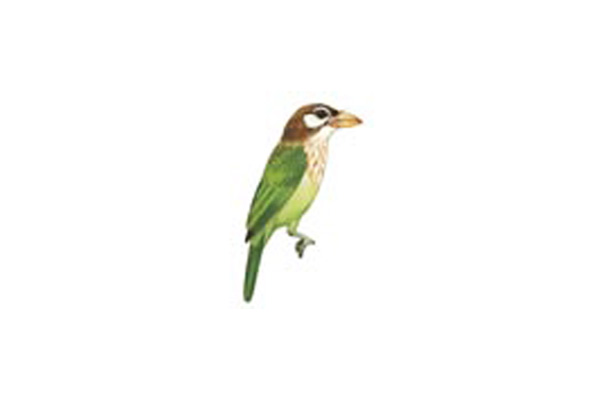
23 cm: Resident of the Western Ghats and the hills of Tamil Nadu. It has brownish bill, white supercilium and cheeks contrasting with brown crown and nape, whitish throat and bold white streaking on breast. Its call is a pucock, pucock, pucock. Habitat: Wooded areas, gardens, groves
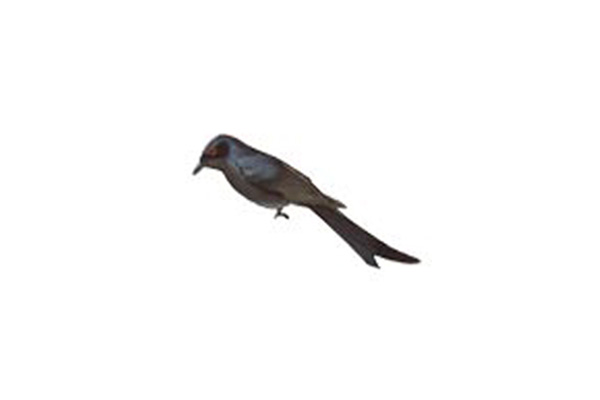
29 cm: Breeds in the Himalayas and northeast Indian hills; winters in plains in the peninsula and Sri Lanka. Adult has dark grey under-parts and slate-grey upper-parts with blue-grey gloss; iris bright red. First-winter has brownish-grey under-parts with indistinct pale fringes. Juvenile is black. Habitat: Breeds in forests; winters in well-wooded areas
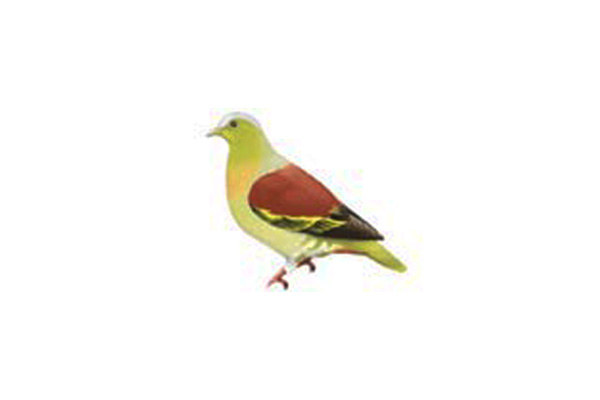
28 cm: Resident of the Himalayas, hills of northeast and southwest India, Bangladesh and Sri Lanka. Sexes are distinguished from thick-billed green bill by thin blue-grey bill and lack of prominent greenish orbital skin. Male has maroon mantle; where range overlaps with thick-billed, it has diffuse orange patch on breast, greenish-yellow throat and uniform chestnut under-tail coverts. Female lacks maroon mantle. Habitat: Tropical and subtropical moist broad-leaved forests and well-wooded areas
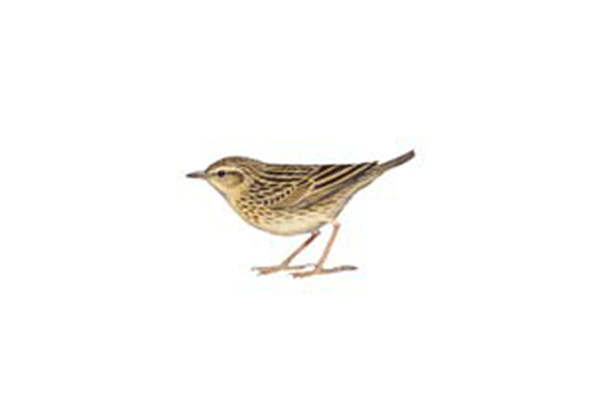
17 cm: Resident of the southwest Indian hills. It has large, heavily streaked pipit. Compared with Paddyfield, has shorter tail, more heavily streaked upper-parts, and streaked upper belly and flanks, and lacks malar stripe and patch. Call a weak see-see, quite unlike Paddyfield's call. Habitat: Grassy slopes
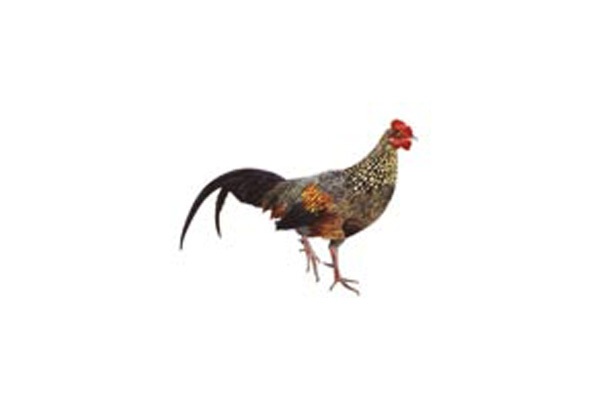
M 66-72.5 cm, F 35 cm: Resident of Sri Lanka. Male has orange-red under-parts, yellow spot on comb, elongated orange feathers covering entire mantle, and purple-black wings and tail. Apparently does not have eclipse plumage. Female has white streaks on the breast, and black-and-white patterning to belly. Habitat: Forests
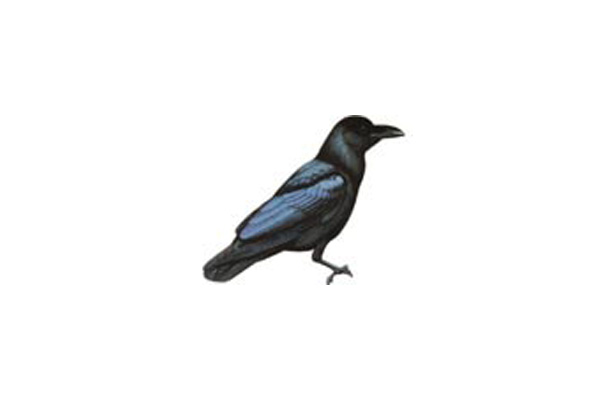
46-59 cm: Widespread resident. All black, lacking paler collar of House Crow. Domed head and large bill with arched culmen. The two Himalayan forms are bigger and with heavier bill, wedge-shaped tail, and harsher calls, compared with those in the 'plains'. Himalayan forms best told from Raven by absence of throat hackles, shorter and broader wings, less strongly wedge-shaped tail, squarer or domed crown and dry kaaa-kaaa call. Habitat: Wide range of habitats, except deserts and semi-deserts.
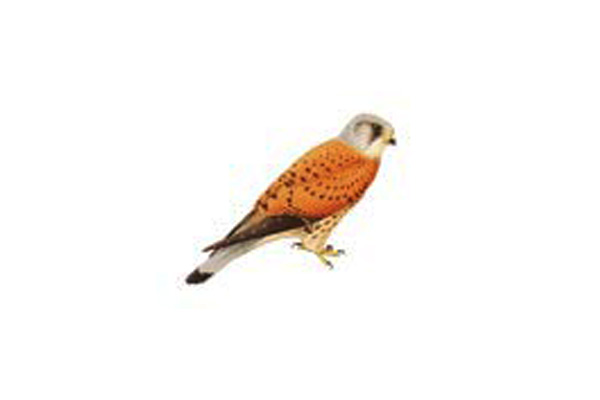
32-35 cm: Winter visitor. Long, rather broad tail; wing-tips more rounded than on most falcons. Frequently hovers. Male has greyish head with diffused dark moustachial stripe, rufousupperparts heavily marked with black, and grey tail with black sub-terminal band. Female and juvenile have rufous crown and nape streaked with black, diffused and narrow dark moustachial stripe, rufousupperparts heavily barred and spotted with black, and dark barring on rufous tail; under-wing more heavily barred than male's.
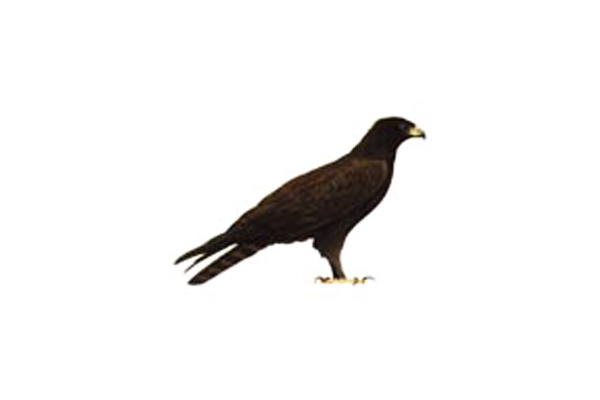
69-81 cm: Distinctive wing shape, and long-tail. Flies with wings raised in a V, and primaries upturned. At rest, long wings extend to tip of tail. Adult is dark brownish-black, with striking yellow cere and feet; in flight, shows whitish barring on upper-tail coverts, and faint greyish barring on tail and underside of remiges. Juvenile has dark-streaked buffish head, under-parts and under-wing coverts. Habitat: Broad-leaved forests on hills and mountains
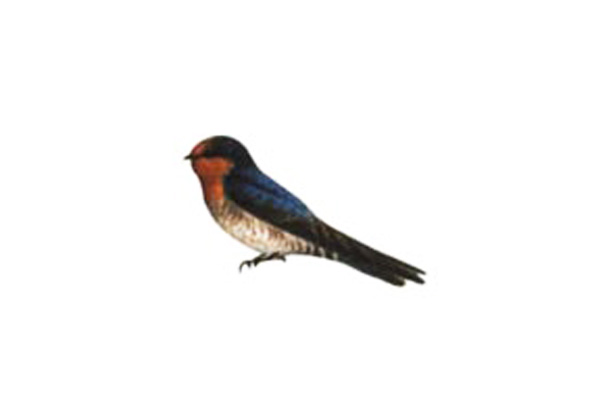
13 cm: Resident of southwest Indian hills, Andamans and Sri Lanka. Distinguished from Barn by more extensive rufous on throat, lack of breast-band, dingy under-parts and under-wing coverts, and blackish under-tail coverts with whitish fringes; lacks tail-streamers. Habitat: Grassy hills and rivers
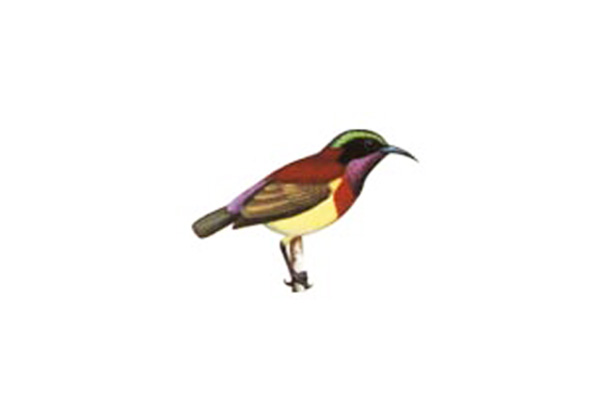
8 cm: A resident of the hills of west India. Smaller and finer-billed than the Purple-rumped species. Male has broad crimson breast-band and mantle. Female has crimson rump. Eclipse male has crimson back and purple rump. Calls include a flower-pecker-like thlick-thlick. Habitat: Evergreen forests and plantations
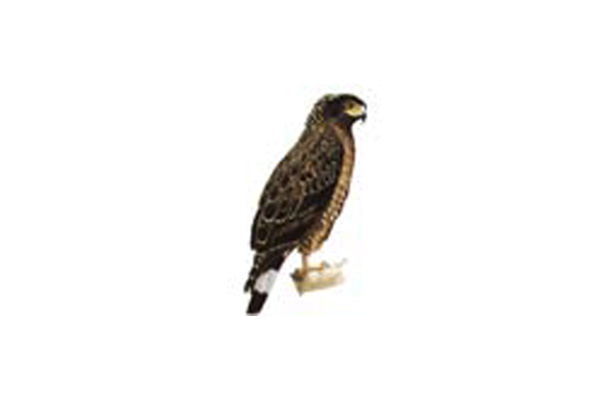
56-74 cm: Widespread resident, unrecorded in most of northwest and northeast India. It has broad, rounded wings. Soars with wings held forward and in a pronounced V. Adult has broad white bands across wings and tail; hooded appearance at rest, with yellow cere and lores, and white spotting on brown under-parts. Juvenile has blackish ear-coverts, yellow cere and lores, whitish head and under-parts, narrower barring on tail, and largely white under-wing with fine dark tailing edge.
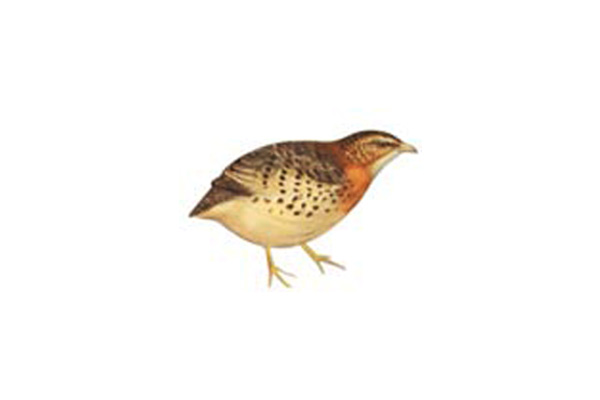
15-16 cm: Mainly resident; summer visitor to the northwest. It is widespread, chiefly in lowlands. It has yellow legs and bill, comparatively uniform upper-parts and buff coverts with bold black spotting. Pattern and coloration of under-parts are very different from Barred. Low-pitched hoot, repeated with increasing strength, becoming human-like moan. Habitat: Scrubs, grasslands and crops
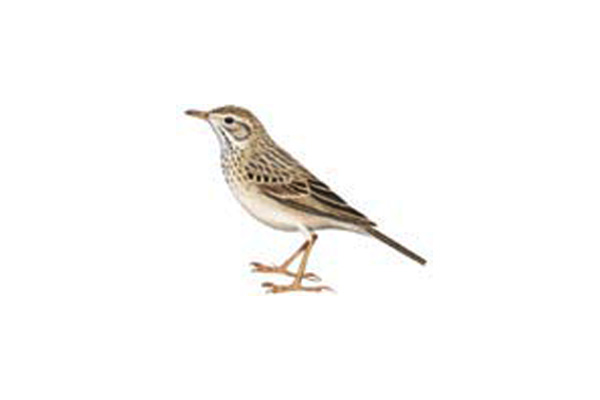
15 cm: Widespread resident, except in parts of northeast and northwest subcontinent. Smaller than Richard's, with chip-chip-chip call. Well-streaked breast; lores usually look pale. When flushed, has comparatively weak, rather fluttering flight. Habitat: Short grasslands and cultivation
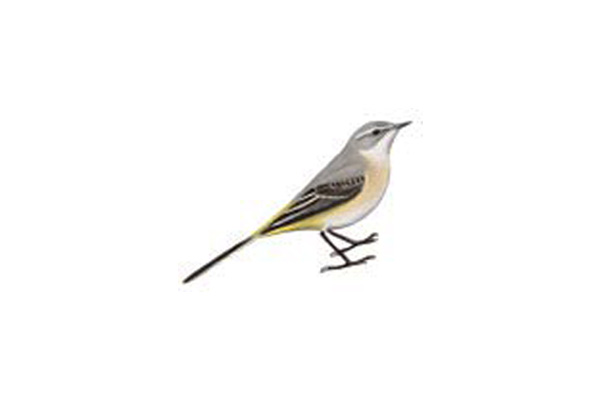
19 cm: Widespread in winter. It is longer-tailed than other wagtails, with white supercilium, grey upper parts, and yellow vent and under-tail coverts. Male has black throat when breeding. Breeds by mountain streams; winters by slower streams in lowlands and foothills.
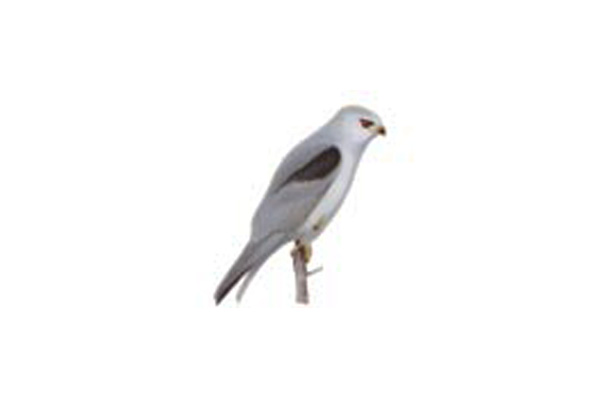
31-35 cm: Widespread resident; unrecorded in parts of northeast and northwest. It is small in size, grey and white with black 'shoulders'. Flight is buoyant, with much hovering. Juvenile has brownish-grey upperparts with pale fringes, with less distinct shoulder patch. Habitat: Grasslands with cultivation and open scrubs
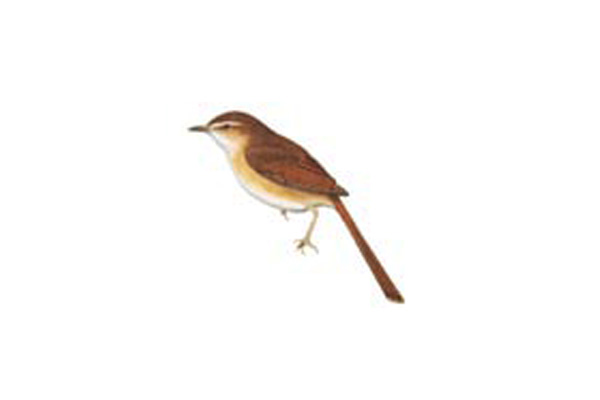
13 cm: Widespread resident. It is smaller than Jungle, with finer bill. It has pale or rufous fringes to tertails. Song is a rapid trill, tlicktlicktlick; calls include plaintive tee-tee-tee and nasal beep. Habitat: Tall crops, reeds, grassland, scrub and tall grass, and mangroves
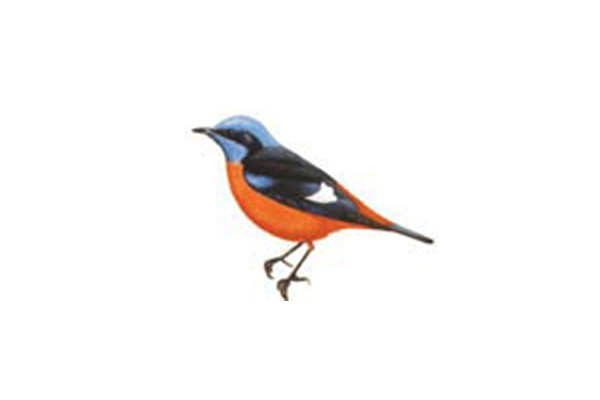
17 cm: Summer visitor to the Himalayas and northeast India; winters mainly in the Western Ghats and Assam hills. Male has white wing patch and blue-black tail; blue crown and throat and orange under-parts, obscured by pale fringes in non-breeding and first-winter plumages. Female has uniform olive-brown upper-parts; lacks buff neck patch of Chestnut-bellied and orange-red tail of Rufous-tailed. Habitat: Summers in open dry forest; winters in moist forest and well-wooded areas.
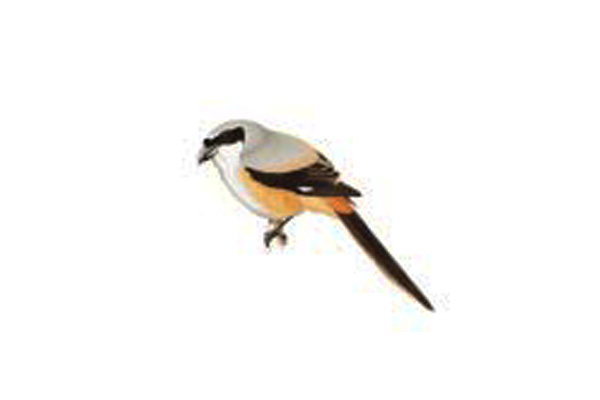
25 cm: Widespread resident. Adult has grey mantle, rufous scapulars and upper back, narrow black forehead, rufous sides to black tail, and small white patch on primaries. Juvenile has (dark-barred) rufous-brown scapulars, back and rump; dark greater coverts and tertails fringed rufous. Himalayan tricolor has black hood. Habitat: Bushes in cultivation, open forest and gardens
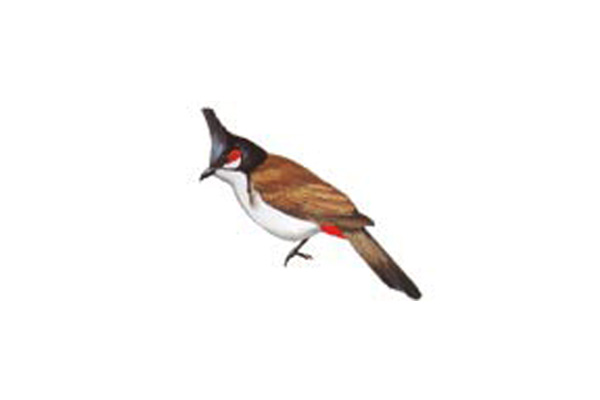
20 cm: Widespread resident; unrecorded in Pakistan, parts of north and northwest India and Sri Lanka. It has black crest, red 'whiskers' and white under-parts with complete or broken breast-band and red vent. Juvenile is duller and lacks 'whiskers'. Habitat: Open forests and secondary growth
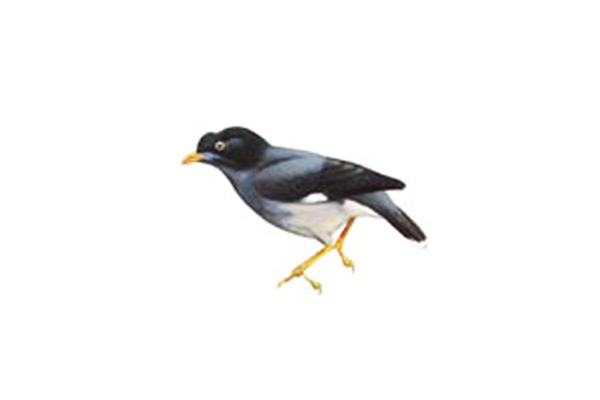
23 cm: Resident of Himalayas, south to Bangladesh north of Orissa, and west India. It has tufted forehead, and white wing patch and tail-tip; lacks bare orbital skin. Juvenile is browner, with reduced forehead tuft. Found in cultivation near well-wooded areas, and edges of habitation.
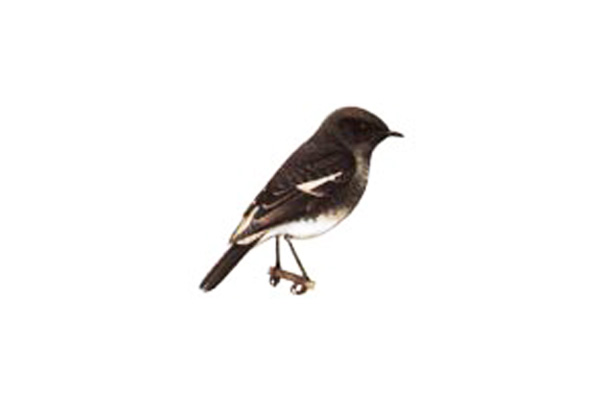
13.5 cm: Widespread resident. Male is black, with white rump and wing patch;rufous fringes to body in non-breeding and first-winter plumages. Female has dark brown upper-parts, with rufous-orange rump. Habitat: Cultivation and open country with scattered bushes or tall grass
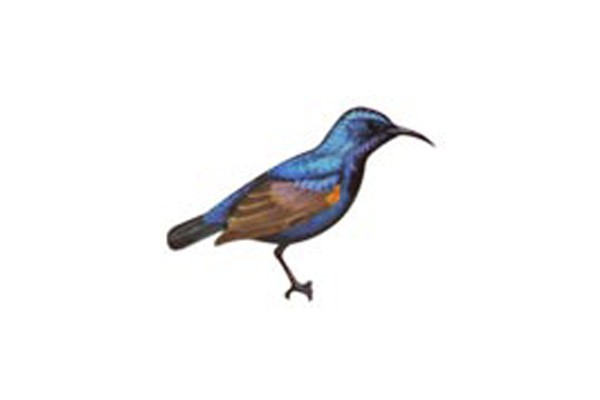
10 cm: Widespread resident; unrecorded in parts of northeast and northwest subcontinent. Male is metallic purple. Female has uniform yellowish under-parts, with faint supercilium and darker mask. Call is buzzing zit and high-pitched, wheezy swee. Habitat: Open deciduous forests and gardens
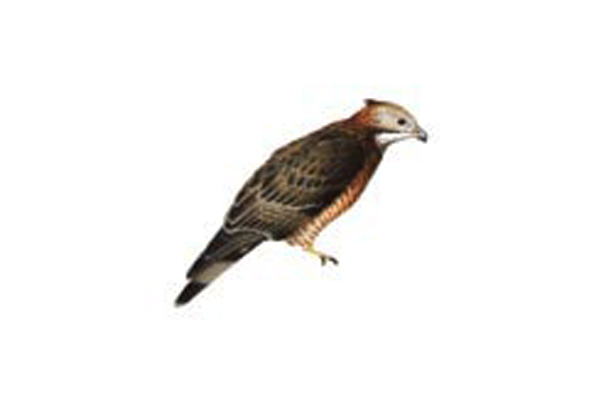
57-60 cm: Widespread resident; absent in parts of northwest and northeast subcontinent. Wings and tail are long and broad, has narrow neck and small head. It soars with wings flat. Has small crest. Very variable in plumage, with under-parts and under-wing coverts ranging from dark brown through rufous to white, and unmarked, streaked or barred; often shows dark moustachial stripe and gular stripe, and gorget of streaking across lower throat. It lacks dark carpal patch.
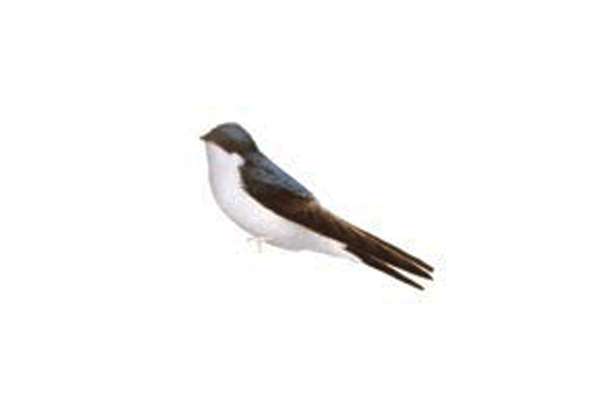
13 cm: Summer visitor to the West Himalayas; mainly passage migrant elsewhere. Adult told from Asian House martin by combination of whiter under-parts, longer and more deeply forked tail, and paler under-wing coverts. Juvenile has less glossy upper-parts, is rather dingy underneath, and has shallower tail-fork.
Many rare varieties of wild orchids grow spontaneously on the trees and rocks in these regions. Wild mallows, balsams, creepers, beans, hemp, ferns, lichens, etc. fill the ground below the giant parasols spread out sky high by the hundreds of tall endemic trees. Organic cardamom plantation and other garden plants cover the whole area in sparkling greenery and bright colours throughout the year. The trees are so old and so tall that you feel miniaturised by the strength and stature of nature.
A robust shrub, planted in gardens and backyards for decorative and medicinal purposes, seen typically near roadsides and along watercourses. Flowers lack nectar. Caterpillars of Emigrant butterflies feed on this plant. Leaves are used in traditional medicine.
Flowering: October - June
An erect perennial, with angled, lobed and toothed leaves. It is seen along roadsides on the hills. Seed capsule covered with bristles, which catch on to animal fur to help in seed dispersal. Cultivated for termite-and water-resistant fibre used in making fishing line, rope and binding cord. Roots and flowers are used in traditional medicine.
Flowering: January - December